Africa · Attractions · Going Out · Malawi · Regions
5 places to visit in central Malawi
Although it is home to the country’s capital and main airport, Central Malawi is not as popular with visitors as the better-known attractions to the south of the country. But it does have plenty of places to visit and great experiences on offer, all within relatively easy access of the point where most people enter the country, Lilongwe. In this blog we’re rounding up just 5 of the places to visit in Central Malawi.
Lilongwe
Although many visitors to Malawi may be limited to a single night (if that) in Lilongwe as they head further afield to sample the country’s varied delights, it is a city with plenty of character and sufficient attractions to easily fill a few days.
It is made up of two very distinct settlements: the modern Capital City and the traditional Old Town – and a charming Nature Sanctuary lies between the two! Even the Old Town has only a relatively short history- its population at the turn of the 20th century was just a couple of dozen – and the Capital City was a largely artificial creation of the late 20th Century.
 Lilongwe Old Town is a typical bustling African town. The central hub of the Old Town is where banks, the post office and a few more modern shopping areas are found. It is also home to an excellent craft market that occupies the parking area outside the post office. Goods for sale are neatly laid out on the ground but so closely packed that it is impossible to tell where one trader’s wares end and another’s begin. Friendly negotiation is the order of the day if wishing to buy!. Most of the items for sale are wood and stone carvings of good quality but there are also paintings and basket-ware. Traditional chiefs’ chairs and small three-legged folding tables are popular buys.
Lilongwe Old Town is a typical bustling African town. The central hub of the Old Town is where banks, the post office and a few more modern shopping areas are found. It is also home to an excellent craft market that occupies the parking area outside the post office. Goods for sale are neatly laid out on the ground but so closely packed that it is impossible to tell where one trader’s wares end and another’s begin. Friendly negotiation is the order of the day if wishing to buy!. Most of the items for sale are wood and stone carvings of good quality but there are also paintings and basket-ware. Traditional chiefs’ chairs and small three-legged folding tables are popular buys.
 Just over the river is a concentration of local shops and the traditional walled market. During the latter days of the Banda regime, customers needed a Malawi Congress Party membership card in order to enter the market. Today all are welcome. The market is a mixture of order and chaos. Each stall is neatly laid out with its wares carefully arranged but the general impression is one of total confusion. As in markets the world over, competing traders occupy adjacent stalls. Thus, there are areas for vegetables, concentrations of fish sellers and so on. Vegetables are laid in neat rows, piled into pyramids and arranged like some wonderfully dressed army on parade. Live chickens, fly-blown meat and malodorous fish, gleaming steel buckets and watering cans, all vie for space. Apart from all the shoppers and the traders, tinkers work inside the market adding the sounds of hammer on metal to the general hubbub of animated conversation and the cries of the stall-holders. This is definitely a place not to miss on even the shortest stay in Lilongwe.
Just over the river is a concentration of local shops and the traditional walled market. During the latter days of the Banda regime, customers needed a Malawi Congress Party membership card in order to enter the market. Today all are welcome. The market is a mixture of order and chaos. Each stall is neatly laid out with its wares carefully arranged but the general impression is one of total confusion. As in markets the world over, competing traders occupy adjacent stalls. Thus, there are areas for vegetables, concentrations of fish sellers and so on. Vegetables are laid in neat rows, piled into pyramids and arranged like some wonderfully dressed army on parade. Live chickens, fly-blown meat and malodorous fish, gleaming steel buckets and watering cans, all vie for space. Apart from all the shoppers and the traders, tinkers work inside the market adding the sounds of hammer on metal to the general hubbub of animated conversation and the cries of the stall-holders. This is definitely a place not to miss on even the shortest stay in Lilongwe.
 Something of a curiosity for a modern African capital, though a very welcome one, the Lilongwe Nature Sanctuary is a 150-hectare area of protected woodland separating the Old Town from the modern Capital City. Trails enable the visitor to walk down towards the Lingadzi River through mixed woodland. The birdlife is good and there is a chance of seeing a few larger mammals, including monkeys, bushbucks and duiker, as well as crocodiles in the river. There aren’t many capital cities that allow for such nature walks and animal encounters at their very heart. One part of the sanctuary is the Lilongwe Wildlife Centre, an award-winning operation that provides shelter and rehabilitation for wild animals rescued from outside the country’s protected areas. The main intention with all animals admitted is to return them to the wild but some have become permanent residents by necessity. There are guided tours and also great opportunities to volunteer and be part of this excellent work. The Lilongwe Wildlife Trust responsible for the Centre is also a very strong campaigning voice in Malawi for the protection of wildlife and has achieved notable successes.
In stark contrast to the very African character of the Old Town is the modern Capital City. The Capital City is the name given to the modern area north of Old Town which arose largely due to the acquisition of Lilongwe’s status as the country’s capital. It has an (ever growing) scattering of modern, sometimes grand, buildings apparently set down at random in an almost park-like landscape. Broad avenues with large flower-bedded roundabouts add to the impression of spaciousness. The main roads are lined with flowering trees and bushes, jacaranda, acacia and poinsettia providing splashes of colour in different seasons. Smart, clean and tidy it is. A typical African city it isn’t. There are shopping centres, high rise hotels, the new Chinese-built Parliament building and a couple of relatively new memorial sites – the war memorial and the Banda Mausoleum. To the north of Capital City, Capital Hill is the site of most of the government offices, and beyond that are some smart, well-laid-out residential districts.
Something of a curiosity for a modern African capital, though a very welcome one, the Lilongwe Nature Sanctuary is a 150-hectare area of protected woodland separating the Old Town from the modern Capital City. Trails enable the visitor to walk down towards the Lingadzi River through mixed woodland. The birdlife is good and there is a chance of seeing a few larger mammals, including monkeys, bushbucks and duiker, as well as crocodiles in the river. There aren’t many capital cities that allow for such nature walks and animal encounters at their very heart. One part of the sanctuary is the Lilongwe Wildlife Centre, an award-winning operation that provides shelter and rehabilitation for wild animals rescued from outside the country’s protected areas. The main intention with all animals admitted is to return them to the wild but some have become permanent residents by necessity. There are guided tours and also great opportunities to volunteer and be part of this excellent work. The Lilongwe Wildlife Trust responsible for the Centre is also a very strong campaigning voice in Malawi for the protection of wildlife and has achieved notable successes.
In stark contrast to the very African character of the Old Town is the modern Capital City. The Capital City is the name given to the modern area north of Old Town which arose largely due to the acquisition of Lilongwe’s status as the country’s capital. It has an (ever growing) scattering of modern, sometimes grand, buildings apparently set down at random in an almost park-like landscape. Broad avenues with large flower-bedded roundabouts add to the impression of spaciousness. The main roads are lined with flowering trees and bushes, jacaranda, acacia and poinsettia providing splashes of colour in different seasons. Smart, clean and tidy it is. A typical African city it isn’t. There are shopping centres, high rise hotels, the new Chinese-built Parliament building and a couple of relatively new memorial sites – the war memorial and the Banda Mausoleum. To the north of Capital City, Capital Hill is the site of most of the government offices, and beyond that are some smart, well-laid-out residential districts.
 There are a number of first-class hotels in Lilongwe. One which stands head and shoulders above the rest is the new 11-floor 5-star President Walmont Hotel, part of Umodzi Park. Quiet and charming sub-urban guest houses are found in the residential areas, with Heuglin’s Lodge and Africa House Malawi amongst the best. Slightly further out, but still easily accessible, the wonderful Kumbali Country Lodge is found on a dairy farm at the edge of the city. For Old Town, Korea Garden Lodge has a wide range of room types and is good value, and Mafumu Hotel is fast establishing a great reputation.
Nkhotakota Wildlife Reserve
This reserve is the oldest and largest in Malawi. A total of some 1802 square kilometres (695 square miles) of rugged terrain stretches along the edge of the Great Rift Valley and it is the scenery which has long been the reserve’s particular attraction Countless streams and waterfalls cascade from the steep edge of the escarpment and some of Malawi’s most important rivers flow through this wilderness en route to Lake Malawi. There is little truly open ground. Most of the reserve is Brachystegia woodland with patches of tall grass and occasional areas of rainforest and evergreen. Woodland, known as miombo, is characteristic of the wetter areas. It consists of a great variety of trees which are deciduous but which don’t shed their leaves until the new foliage is about to burst forth in a colourful display. It is the attraction of the wilderness as well as the wildlife that lures visitors to the reserve. A walking trip through the woodland can take one back to the days of David Livingstone.
There are a number of first-class hotels in Lilongwe. One which stands head and shoulders above the rest is the new 11-floor 5-star President Walmont Hotel, part of Umodzi Park. Quiet and charming sub-urban guest houses are found in the residential areas, with Heuglin’s Lodge and Africa House Malawi amongst the best. Slightly further out, but still easily accessible, the wonderful Kumbali Country Lodge is found on a dairy farm at the edge of the city. For Old Town, Korea Garden Lodge has a wide range of room types and is good value, and Mafumu Hotel is fast establishing a great reputation.
Nkhotakota Wildlife Reserve
This reserve is the oldest and largest in Malawi. A total of some 1802 square kilometres (695 square miles) of rugged terrain stretches along the edge of the Great Rift Valley and it is the scenery which has long been the reserve’s particular attraction Countless streams and waterfalls cascade from the steep edge of the escarpment and some of Malawi’s most important rivers flow through this wilderness en route to Lake Malawi. There is little truly open ground. Most of the reserve is Brachystegia woodland with patches of tall grass and occasional areas of rainforest and evergreen. Woodland, known as miombo, is characteristic of the wetter areas. It consists of a great variety of trees which are deciduous but which don’t shed their leaves until the new foliage is about to burst forth in a colourful display. It is the attraction of the wilderness as well as the wildlife that lures visitors to the reserve. A walking trip through the woodland can take one back to the days of David Livingstone.
 In the past, the reserve was known to be home to large numbers of elephants, various species of antelope, including sable, eland, bushbuck, kudu and Lichtenstein’s hartebeest. as well as buffalo and both lion and leopard. In decades past, there were stories of lions attacking mopeds on the road through the reserve, apparently upset by the humming noise of the engines. Sadly, Nkhotakota had become a somewhat forgotten and neglected reserve that was little visited, but things started to change when two privately-run lodges were established there, and then most significantly when African Parks took over its management in 2015. They quickly set about establishing a 15,000 hectare sanctuary in the park and, over a 2 year period, moved a staggering 500 elephants into it, plus another 1000+ other mammals while they were at it! In 2019 that sanctuary was expanded to cover 80,000 acres.
Birdlife has always been very rich. The number of species known to be present is fast approaching 300. The giant kingfisher and the palm nut vulture are among those found here, and two of the bulbuls, the yellow-streaked and the grey-olive are not found in other Malawi national parks and reserves. The wood owl, freckled nightjar and stonechat are common sightings.
In the past, the reserve was known to be home to large numbers of elephants, various species of antelope, including sable, eland, bushbuck, kudu and Lichtenstein’s hartebeest. as well as buffalo and both lion and leopard. In decades past, there were stories of lions attacking mopeds on the road through the reserve, apparently upset by the humming noise of the engines. Sadly, Nkhotakota had become a somewhat forgotten and neglected reserve that was little visited, but things started to change when two privately-run lodges were established there, and then most significantly when African Parks took over its management in 2015. They quickly set about establishing a 15,000 hectare sanctuary in the park and, over a 2 year period, moved a staggering 500 elephants into it, plus another 1000+ other mammals while they were at it! In 2019 that sanctuary was expanded to cover 80,000 acres.
Birdlife has always been very rich. The number of species known to be present is fast approaching 300. The giant kingfisher and the palm nut vulture are among those found here, and two of the bulbuls, the yellow-streaked and the grey-olive are not found in other Malawi national parks and reserves. The wood owl, freckled nightjar and stonechat are common sightings.
 There is also a reasonable certainty of fish life in the larger rivers, especially the two most important, the Bua and the Dwangwa. Most notably the Bua is renowned for its mpasa or lake salmon. In even greater abundance is the smaller sanijka, found in many streams. It’s possible to fish in the rivers, and also explore them on a canoe safari. To get awesome views of the reserve and across to Lake Malawi, Chipata Mountain makes a not too difficult climb. The summit is 1638 metres (5567 feet) and the peak is accessible by a path leading up from the main camp of the same name.
This is a wonderfully exciting reserve to visit now, offering spectacular scenery and the thrilling experience of exploring an untouched wilderness, that now boasts growing and well protected populations of safari animals.
Nkhotakota now has three international-standard lodges within its boundaries. The upmarket, multi-award winning Tongole Wilderness Lodge, it’s simpler sister property Kachenga Bush Camp and the diverse and charming Bua River Lodge. Opened in 2019, Rafiki Safari Camp lies just outside the Reserve’s eastern boundary.
Senga Bay
Senga is one of the most beautiful bays along the western shore of Lake Malawi. It is situated at one of the narrowest points on the lake where the eastern shore is clearly visible. Rocky headlands enclose Senga Bay and round the northern one, Namikombe Point, is a second bay, Leopard’s. From the country’s capital, Lilongwe, this is the closest point on the Lake, reached via the large service town of Salima in around an hour and a half’s drive. As a result of its location and beauty, a collection of lodges and hotels have grown up around the bay. There are beautiful sandy beaches to enjoy, and a wide variety of watersports available, including some wonderful snorkelling opportunities and even water skiing and an inflatable obstacle course! There are also a few excursions on offer for those who can drag themselves off the soft sand or out of the warm waters.
There is also a reasonable certainty of fish life in the larger rivers, especially the two most important, the Bua and the Dwangwa. Most notably the Bua is renowned for its mpasa or lake salmon. In even greater abundance is the smaller sanijka, found in many streams. It’s possible to fish in the rivers, and also explore them on a canoe safari. To get awesome views of the reserve and across to Lake Malawi, Chipata Mountain makes a not too difficult climb. The summit is 1638 metres (5567 feet) and the peak is accessible by a path leading up from the main camp of the same name.
This is a wonderfully exciting reserve to visit now, offering spectacular scenery and the thrilling experience of exploring an untouched wilderness, that now boasts growing and well protected populations of safari animals.
Nkhotakota now has three international-standard lodges within its boundaries. The upmarket, multi-award winning Tongole Wilderness Lodge, it’s simpler sister property Kachenga Bush Camp and the diverse and charming Bua River Lodge. Opened in 2019, Rafiki Safari Camp lies just outside the Reserve’s eastern boundary.
Senga Bay
Senga is one of the most beautiful bays along the western shore of Lake Malawi. It is situated at one of the narrowest points on the lake where the eastern shore is clearly visible. Rocky headlands enclose Senga Bay and round the northern one, Namikombe Point, is a second bay, Leopard’s. From the country’s capital, Lilongwe, this is the closest point on the Lake, reached via the large service town of Salima in around an hour and a half’s drive. As a result of its location and beauty, a collection of lodges and hotels have grown up around the bay. There are beautiful sandy beaches to enjoy, and a wide variety of watersports available, including some wonderful snorkelling opportunities and even water skiing and an inflatable obstacle course! There are also a few excursions on offer for those who can drag themselves off the soft sand or out of the warm waters.
 Just a couple of kilometres off-shore is Namalenje Island, which is colonised by birds, including cormorants and fish eagles, and can be visited on a boat trip. Monitor lizards share the island whose rocks and trees are stained white with guano. Despite occasional scare stories, hippos are rarely seen in Lake Malawi but inland from Senga Bay there are a couple of pools where visitors can go and spot a few of these huge grey beasts. Senga is also home to the tropical fish farm established by Stuart Grant. Lake Malawi cichlids are highly prized aquarium fish and the farm was set up to breed them for export the North American and European tropical fish markets.
Because of the popularity of Senga Bay, there is a line of craft stalls along the main road down to the bay where. There can be over 100 metre stretches of stalls on both sides of the road. There are some high quality products on sale, especially the wood carvings, and for something personal, your name can carved onto a key tag in the shape of a fish!
Just a couple of kilometres off-shore is Namalenje Island, which is colonised by birds, including cormorants and fish eagles, and can be visited on a boat trip. Monitor lizards share the island whose rocks and trees are stained white with guano. Despite occasional scare stories, hippos are rarely seen in Lake Malawi but inland from Senga Bay there are a couple of pools where visitors can go and spot a few of these huge grey beasts. Senga is also home to the tropical fish farm established by Stuart Grant. Lake Malawi cichlids are highly prized aquarium fish and the farm was set up to breed them for export the North American and European tropical fish markets.
Because of the popularity of Senga Bay, there is a line of craft stalls along the main road down to the bay where. There can be over 100 metre stretches of stalls on both sides of the road. There are some high quality products on sale, especially the wood carvings, and for something personal, your name can carved onto a key tag in the shape of a fish!
 Senga Bay has a variety of accommodation available. Kumbali Lake Retreat is one of the newest, a charming rustic eco lodge. Blue Waters by Serendib has plenty of facilities and activities available and is one of the more popular hotels. But the most luxurious lodge in the area is actually a 15 minute boat trip off shore from Senga Bay, on the uninhabited Marelli Islands, which are part of the Lake Malawi National Park. That is Blue Zebra Island Lodge, a real gem.
Dedza & Chongoni
Dedza township lies roughly 80 km south of Lilongwe, at an altitude of 1600 metres, making it the highest town in Malawi. Dedza is a pleasant forestry town and an important centre for a this long-settled area. Perhaps because of its attractive moist and cool climate various groups have made the area their home over the centuries. Evidence of some of the earliest of those settlers can be found in the Chongoni Rock Art site close to Dedza. This is a World Heritage Site, one of only two in Malawi. Rock shelters, dating from Neolithic times contain geometric paintings, the work of the Batwa people who hunted the then abundant wildlife on the cool slopes of the plateau. There is a wonderful sense of history to be felt standing in the homes of the hunters and food gatherers who inhabited the area two or three thousand years ago.
Senga Bay has a variety of accommodation available. Kumbali Lake Retreat is one of the newest, a charming rustic eco lodge. Blue Waters by Serendib has plenty of facilities and activities available and is one of the more popular hotels. But the most luxurious lodge in the area is actually a 15 minute boat trip off shore from Senga Bay, on the uninhabited Marelli Islands, which are part of the Lake Malawi National Park. That is Blue Zebra Island Lodge, a real gem.
Dedza & Chongoni
Dedza township lies roughly 80 km south of Lilongwe, at an altitude of 1600 metres, making it the highest town in Malawi. Dedza is a pleasant forestry town and an important centre for a this long-settled area. Perhaps because of its attractive moist and cool climate various groups have made the area their home over the centuries. Evidence of some of the earliest of those settlers can be found in the Chongoni Rock Art site close to Dedza. This is a World Heritage Site, one of only two in Malawi. Rock shelters, dating from Neolithic times contain geometric paintings, the work of the Batwa people who hunted the then abundant wildlife on the cool slopes of the plateau. There is a wonderful sense of history to be felt standing in the homes of the hunters and food gatherers who inhabited the area two or three thousand years ago.
 It is possible to hike up the Dedza Mountain (2170 metres) in the forest reserve north of the town. Given a bright day the effort is worth it because once up on the ridge there are spectacular views to the east. In clear air it is possible to see right across Lake Malawi and into Mozambique.
However, many visitors arrive in Dedza simply to visit the township’s famous pottery. The workshops are on the edge of the town, near to the main M1 road. The brick buildings, with their smoking chimneys, are quite extensive. It is possible to watch the potters at work and a tour of the workshop can usually be arranged without prior notice. Much of the pottery is colourful with hand-painted designs, many distinctly African in nature. Many of Malawi’s lodges and hotels use Dedza Pottery products in their restaurants or even when decorating guest rooms. Should you want something unusual or have a specific design in mind, this can be arranged and the finished work forwarded to you by the pottery. If the pots don’t impress, the cakes in the garden teashop behind the workshops are well worth investigating. Tables and chairs are arranged in a neatly kept garden and this is a fine place to rest on a journey between Lilongwe and Blantyre.
It is possible to hike up the Dedza Mountain (2170 metres) in the forest reserve north of the town. Given a bright day the effort is worth it because once up on the ridge there are spectacular views to the east. In clear air it is possible to see right across Lake Malawi and into Mozambique.
However, many visitors arrive in Dedza simply to visit the township’s famous pottery. The workshops are on the edge of the town, near to the main M1 road. The brick buildings, with their smoking chimneys, are quite extensive. It is possible to watch the potters at work and a tour of the workshop can usually be arranged without prior notice. Much of the pottery is colourful with hand-painted designs, many distinctly African in nature. Many of Malawi’s lodges and hotels use Dedza Pottery products in their restaurants or even when decorating guest rooms. Should you want something unusual or have a specific design in mind, this can be arranged and the finished work forwarded to you by the pottery. If the pots don’t impress, the cakes in the garden teashop behind the workshops are well worth investigating. Tables and chairs are arranged in a neatly kept garden and this is a fine place to rest on a journey between Lilongwe and Blantyre.
 Mua Mission
Found just off the M5 ‘lakeshore’ road 65 km south of Salima, Mua was the first mission established in Malawi by the Roman Catholic Church, over 100 years ago, back in 1899. The Mua parish, run by the White Fathers, dates from 1903 and stretches from the escarpment, bordering the Great Rift Valley, down to the plains by Lake Malawi. A village has grown up round the nucleus of the parish buildings.
The modern development of the mission owes mush to a Canadian White Father, Claude Boucher, who founded the KuNgoni Centre of Culture & Art in 1976. The aim was to harness the skills of local craftsmen and preserve and celebrate the richness of Malawian culture. A museum has been established and the mission now acts as a school for wood carvers who will later make their own living from their handiwork throughout Malawi and beyond. The work is not limited to wood carving; pottery, paintings and batiks are also produced.
Mua Mission
Found just off the M5 ‘lakeshore’ road 65 km south of Salima, Mua was the first mission established in Malawi by the Roman Catholic Church, over 100 years ago, back in 1899. The Mua parish, run by the White Fathers, dates from 1903 and stretches from the escarpment, bordering the Great Rift Valley, down to the plains by Lake Malawi. A village has grown up round the nucleus of the parish buildings.
The modern development of the mission owes mush to a Canadian White Father, Claude Boucher, who founded the KuNgoni Centre of Culture & Art in 1976. The aim was to harness the skills of local craftsmen and preserve and celebrate the richness of Malawian culture. A museum has been established and the mission now acts as a school for wood carvers who will later make their own living from their handiwork throughout Malawi and beyond. The work is not limited to wood carving; pottery, paintings and batiks are also produced.
 Visitors can see the woodcarvers at work in large open-sided rondavels with heavy thatched roofs providing shade. The pillars supporting the roofs have been carved with scenes portraying the history of Malawi. Much of the work done by these quite extraordinarily skilled craftsmen finds a home in churches around Malawi and overseas but there is a small shop on site which sells smaller and largely secular carvings to visitors. For ridiculously low prices, considering the skills on show, one can come away with a piece of real artistic merit
Visitors can see the woodcarvers at work in large open-sided rondavels with heavy thatched roofs providing shade. The pillars supporting the roofs have been carved with scenes portraying the history of Malawi. Much of the work done by these quite extraordinarily skilled craftsmen finds a home in churches around Malawi and overseas but there is a small shop on site which sells smaller and largely secular carvings to visitors. For ridiculously low prices, considering the skills on show, one can come away with a piece of real artistic merit
 The fascinating Chamare Museum gives a wonderful insight into Malawian history and cuylture. Its exhibits are unique and well worth a visit. It takes at least an hour, and a knowledgeable guide to Properly to appreciate the museum. The outer walls of the building are painted with murals telling the history of Malawi. Inside, the museum displays various exhibits telling the story of the mission, and celebrating the three ethnic groups of Central Malawi: Chewa, Yao and Ngoni.
Kelly White is Director of the Malawi Travel Marketing Consortium. Malawi Travel Marketing Consortium aims to provide you with the best information to make Malawi your tourism destination.
If you would like to be a guest blogger on A Luxury Travel Blog in order to raise your profile, please contact us.
The fascinating Chamare Museum gives a wonderful insight into Malawian history and cuylture. Its exhibits are unique and well worth a visit. It takes at least an hour, and a knowledgeable guide to Properly to appreciate the museum. The outer walls of the building are painted with murals telling the history of Malawi. Inside, the museum displays various exhibits telling the story of the mission, and celebrating the three ethnic groups of Central Malawi: Chewa, Yao and Ngoni.
Kelly White is Director of the Malawi Travel Marketing Consortium. Malawi Travel Marketing Consortium aims to provide you with the best information to make Malawi your tourism destination.
If you would like to be a guest blogger on A Luxury Travel Blog in order to raise your profile, please contact us.
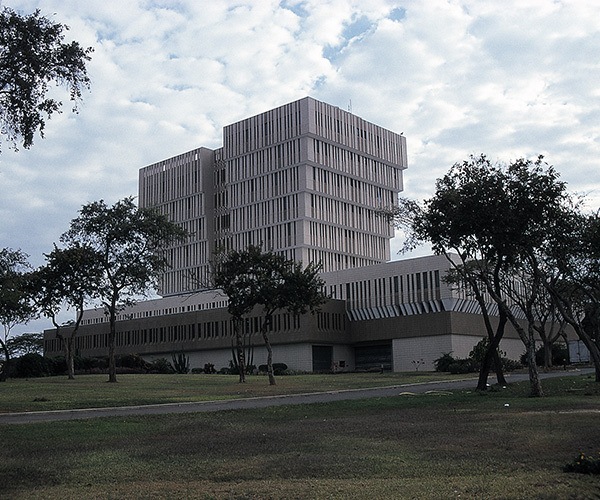 Lilongwe Old Town is a typical bustling African town. The central hub of the Old Town is where banks, the post office and a few more modern shopping areas are found. It is also home to an excellent craft market that occupies the parking area outside the post office. Goods for sale are neatly laid out on the ground but so closely packed that it is impossible to tell where one trader’s wares end and another’s begin. Friendly negotiation is the order of the day if wishing to buy!. Most of the items for sale are wood and stone carvings of good quality but there are also paintings and basket-ware. Traditional chiefs’ chairs and small three-legged folding tables are popular buys.
Lilongwe Old Town is a typical bustling African town. The central hub of the Old Town is where banks, the post office and a few more modern shopping areas are found. It is also home to an excellent craft market that occupies the parking area outside the post office. Goods for sale are neatly laid out on the ground but so closely packed that it is impossible to tell where one trader’s wares end and another’s begin. Friendly negotiation is the order of the day if wishing to buy!. Most of the items for sale are wood and stone carvings of good quality but there are also paintings and basket-ware. Traditional chiefs’ chairs and small three-legged folding tables are popular buys.
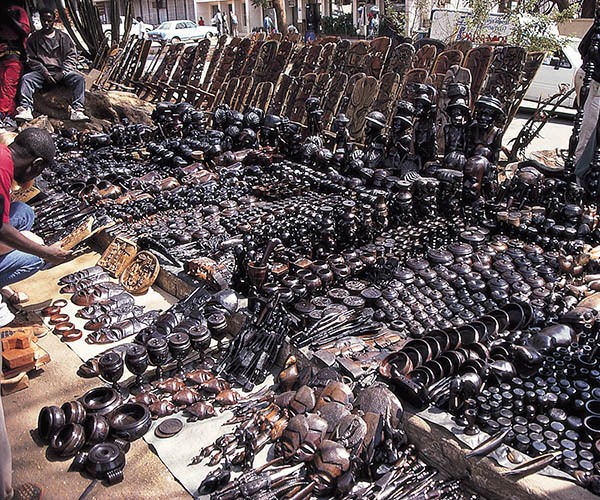 Just over the river is a concentration of local shops and the traditional walled market. During the latter days of the Banda regime, customers needed a Malawi Congress Party membership card in order to enter the market. Today all are welcome. The market is a mixture of order and chaos. Each stall is neatly laid out with its wares carefully arranged but the general impression is one of total confusion. As in markets the world over, competing traders occupy adjacent stalls. Thus, there are areas for vegetables, concentrations of fish sellers and so on. Vegetables are laid in neat rows, piled into pyramids and arranged like some wonderfully dressed army on parade. Live chickens, fly-blown meat and malodorous fish, gleaming steel buckets and watering cans, all vie for space. Apart from all the shoppers and the traders, tinkers work inside the market adding the sounds of hammer on metal to the general hubbub of animated conversation and the cries of the stall-holders. This is definitely a place not to miss on even the shortest stay in Lilongwe.
Just over the river is a concentration of local shops and the traditional walled market. During the latter days of the Banda regime, customers needed a Malawi Congress Party membership card in order to enter the market. Today all are welcome. The market is a mixture of order and chaos. Each stall is neatly laid out with its wares carefully arranged but the general impression is one of total confusion. As in markets the world over, competing traders occupy adjacent stalls. Thus, there are areas for vegetables, concentrations of fish sellers and so on. Vegetables are laid in neat rows, piled into pyramids and arranged like some wonderfully dressed army on parade. Live chickens, fly-blown meat and malodorous fish, gleaming steel buckets and watering cans, all vie for space. Apart from all the shoppers and the traders, tinkers work inside the market adding the sounds of hammer on metal to the general hubbub of animated conversation and the cries of the stall-holders. This is definitely a place not to miss on even the shortest stay in Lilongwe.
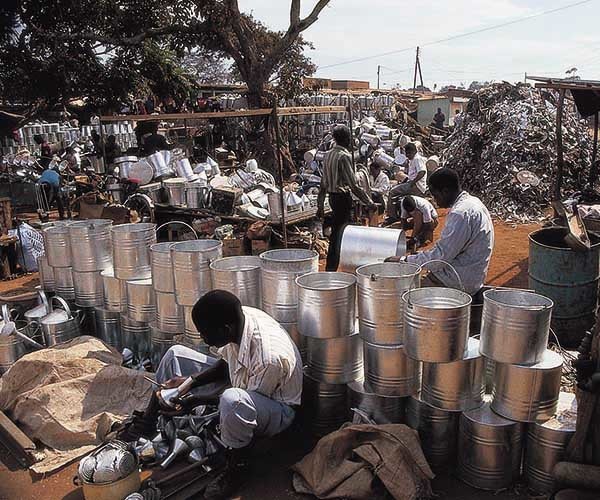 Something of a curiosity for a modern African capital, though a very welcome one, the Lilongwe Nature Sanctuary is a 150-hectare area of protected woodland separating the Old Town from the modern Capital City. Trails enable the visitor to walk down towards the Lingadzi River through mixed woodland. The birdlife is good and there is a chance of seeing a few larger mammals, including monkeys, bushbucks and duiker, as well as crocodiles in the river. There aren’t many capital cities that allow for such nature walks and animal encounters at their very heart. One part of the sanctuary is the Lilongwe Wildlife Centre, an award-winning operation that provides shelter and rehabilitation for wild animals rescued from outside the country’s protected areas. The main intention with all animals admitted is to return them to the wild but some have become permanent residents by necessity. There are guided tours and also great opportunities to volunteer and be part of this excellent work. The Lilongwe Wildlife Trust responsible for the Centre is also a very strong campaigning voice in Malawi for the protection of wildlife and has achieved notable successes.
In stark contrast to the very African character of the Old Town is the modern Capital City. The Capital City is the name given to the modern area north of Old Town which arose largely due to the acquisition of Lilongwe’s status as the country’s capital. It has an (ever growing) scattering of modern, sometimes grand, buildings apparently set down at random in an almost park-like landscape. Broad avenues with large flower-bedded roundabouts add to the impression of spaciousness. The main roads are lined with flowering trees and bushes, jacaranda, acacia and poinsettia providing splashes of colour in different seasons. Smart, clean and tidy it is. A typical African city it isn’t. There are shopping centres, high rise hotels, the new Chinese-built Parliament building and a couple of relatively new memorial sites – the war memorial and the Banda Mausoleum. To the north of Capital City, Capital Hill is the site of most of the government offices, and beyond that are some smart, well-laid-out residential districts.
Something of a curiosity for a modern African capital, though a very welcome one, the Lilongwe Nature Sanctuary is a 150-hectare area of protected woodland separating the Old Town from the modern Capital City. Trails enable the visitor to walk down towards the Lingadzi River through mixed woodland. The birdlife is good and there is a chance of seeing a few larger mammals, including monkeys, bushbucks and duiker, as well as crocodiles in the river. There aren’t many capital cities that allow for such nature walks and animal encounters at their very heart. One part of the sanctuary is the Lilongwe Wildlife Centre, an award-winning operation that provides shelter and rehabilitation for wild animals rescued from outside the country’s protected areas. The main intention with all animals admitted is to return them to the wild but some have become permanent residents by necessity. There are guided tours and also great opportunities to volunteer and be part of this excellent work. The Lilongwe Wildlife Trust responsible for the Centre is also a very strong campaigning voice in Malawi for the protection of wildlife and has achieved notable successes.
In stark contrast to the very African character of the Old Town is the modern Capital City. The Capital City is the name given to the modern area north of Old Town which arose largely due to the acquisition of Lilongwe’s status as the country’s capital. It has an (ever growing) scattering of modern, sometimes grand, buildings apparently set down at random in an almost park-like landscape. Broad avenues with large flower-bedded roundabouts add to the impression of spaciousness. The main roads are lined with flowering trees and bushes, jacaranda, acacia and poinsettia providing splashes of colour in different seasons. Smart, clean and tidy it is. A typical African city it isn’t. There are shopping centres, high rise hotels, the new Chinese-built Parliament building and a couple of relatively new memorial sites – the war memorial and the Banda Mausoleum. To the north of Capital City, Capital Hill is the site of most of the government offices, and beyond that are some smart, well-laid-out residential districts.
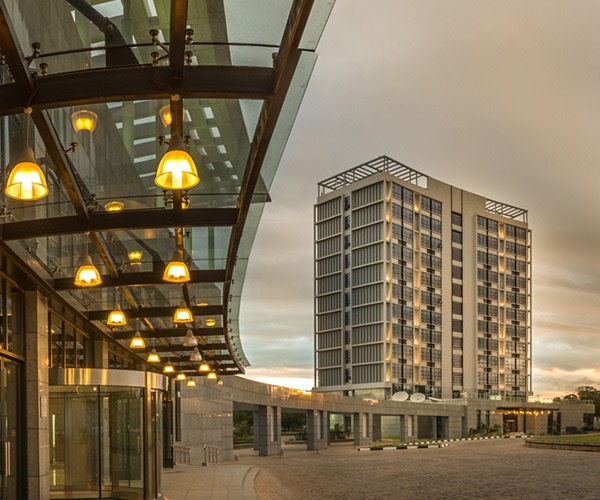 There are a number of first-class hotels in Lilongwe. One which stands head and shoulders above the rest is the new 11-floor 5-star President Walmont Hotel, part of Umodzi Park. Quiet and charming sub-urban guest houses are found in the residential areas, with Heuglin’s Lodge and Africa House Malawi amongst the best. Slightly further out, but still easily accessible, the wonderful Kumbali Country Lodge is found on a dairy farm at the edge of the city. For Old Town, Korea Garden Lodge has a wide range of room types and is good value, and Mafumu Hotel is fast establishing a great reputation.
Nkhotakota Wildlife Reserve
This reserve is the oldest and largest in Malawi. A total of some 1802 square kilometres (695 square miles) of rugged terrain stretches along the edge of the Great Rift Valley and it is the scenery which has long been the reserve’s particular attraction Countless streams and waterfalls cascade from the steep edge of the escarpment and some of Malawi’s most important rivers flow through this wilderness en route to Lake Malawi. There is little truly open ground. Most of the reserve is Brachystegia woodland with patches of tall grass and occasional areas of rainforest and evergreen. Woodland, known as miombo, is characteristic of the wetter areas. It consists of a great variety of trees which are deciduous but which don’t shed their leaves until the new foliage is about to burst forth in a colourful display. It is the attraction of the wilderness as well as the wildlife that lures visitors to the reserve. A walking trip through the woodland can take one back to the days of David Livingstone.
There are a number of first-class hotels in Lilongwe. One which stands head and shoulders above the rest is the new 11-floor 5-star President Walmont Hotel, part of Umodzi Park. Quiet and charming sub-urban guest houses are found in the residential areas, with Heuglin’s Lodge and Africa House Malawi amongst the best. Slightly further out, but still easily accessible, the wonderful Kumbali Country Lodge is found on a dairy farm at the edge of the city. For Old Town, Korea Garden Lodge has a wide range of room types and is good value, and Mafumu Hotel is fast establishing a great reputation.
Nkhotakota Wildlife Reserve
This reserve is the oldest and largest in Malawi. A total of some 1802 square kilometres (695 square miles) of rugged terrain stretches along the edge of the Great Rift Valley and it is the scenery which has long been the reserve’s particular attraction Countless streams and waterfalls cascade from the steep edge of the escarpment and some of Malawi’s most important rivers flow through this wilderness en route to Lake Malawi. There is little truly open ground. Most of the reserve is Brachystegia woodland with patches of tall grass and occasional areas of rainforest and evergreen. Woodland, known as miombo, is characteristic of the wetter areas. It consists of a great variety of trees which are deciduous but which don’t shed their leaves until the new foliage is about to burst forth in a colourful display. It is the attraction of the wilderness as well as the wildlife that lures visitors to the reserve. A walking trip through the woodland can take one back to the days of David Livingstone.
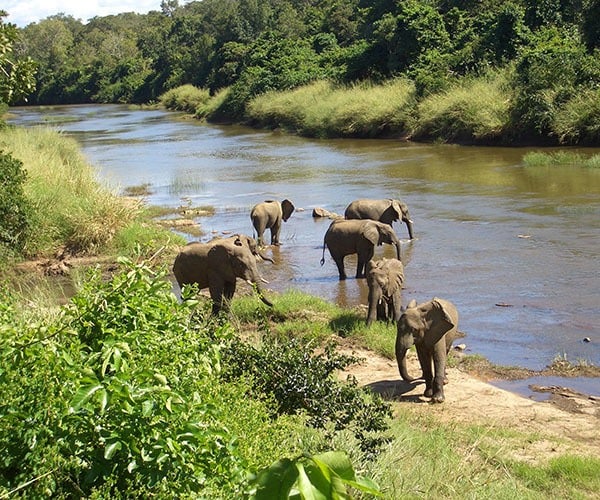 In the past, the reserve was known to be home to large numbers of elephants, various species of antelope, including sable, eland, bushbuck, kudu and Lichtenstein’s hartebeest. as well as buffalo and both lion and leopard. In decades past, there were stories of lions attacking mopeds on the road through the reserve, apparently upset by the humming noise of the engines. Sadly, Nkhotakota had become a somewhat forgotten and neglected reserve that was little visited, but things started to change when two privately-run lodges were established there, and then most significantly when African Parks took over its management in 2015. They quickly set about establishing a 15,000 hectare sanctuary in the park and, over a 2 year period, moved a staggering 500 elephants into it, plus another 1000+ other mammals while they were at it! In 2019 that sanctuary was expanded to cover 80,000 acres.
Birdlife has always been very rich. The number of species known to be present is fast approaching 300. The giant kingfisher and the palm nut vulture are among those found here, and two of the bulbuls, the yellow-streaked and the grey-olive are not found in other Malawi national parks and reserves. The wood owl, freckled nightjar and stonechat are common sightings.
In the past, the reserve was known to be home to large numbers of elephants, various species of antelope, including sable, eland, bushbuck, kudu and Lichtenstein’s hartebeest. as well as buffalo and both lion and leopard. In decades past, there were stories of lions attacking mopeds on the road through the reserve, apparently upset by the humming noise of the engines. Sadly, Nkhotakota had become a somewhat forgotten and neglected reserve that was little visited, but things started to change when two privately-run lodges were established there, and then most significantly when African Parks took over its management in 2015. They quickly set about establishing a 15,000 hectare sanctuary in the park and, over a 2 year period, moved a staggering 500 elephants into it, plus another 1000+ other mammals while they were at it! In 2019 that sanctuary was expanded to cover 80,000 acres.
Birdlife has always been very rich. The number of species known to be present is fast approaching 300. The giant kingfisher and the palm nut vulture are among those found here, and two of the bulbuls, the yellow-streaked and the grey-olive are not found in other Malawi national parks and reserves. The wood owl, freckled nightjar and stonechat are common sightings.
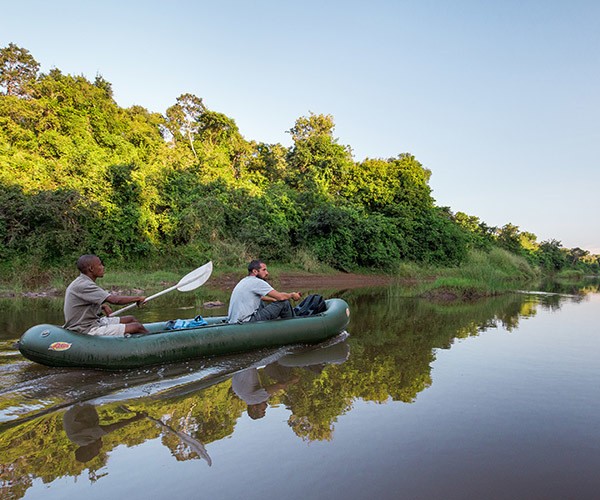 There is also a reasonable certainty of fish life in the larger rivers, especially the two most important, the Bua and the Dwangwa. Most notably the Bua is renowned for its mpasa or lake salmon. In even greater abundance is the smaller sanijka, found in many streams. It’s possible to fish in the rivers, and also explore them on a canoe safari. To get awesome views of the reserve and across to Lake Malawi, Chipata Mountain makes a not too difficult climb. The summit is 1638 metres (5567 feet) and the peak is accessible by a path leading up from the main camp of the same name.
This is a wonderfully exciting reserve to visit now, offering spectacular scenery and the thrilling experience of exploring an untouched wilderness, that now boasts growing and well protected populations of safari animals.
Nkhotakota now has three international-standard lodges within its boundaries. The upmarket, multi-award winning Tongole Wilderness Lodge, it’s simpler sister property Kachenga Bush Camp and the diverse and charming Bua River Lodge. Opened in 2019, Rafiki Safari Camp lies just outside the Reserve’s eastern boundary.
Senga Bay
Senga is one of the most beautiful bays along the western shore of Lake Malawi. It is situated at one of the narrowest points on the lake where the eastern shore is clearly visible. Rocky headlands enclose Senga Bay and round the northern one, Namikombe Point, is a second bay, Leopard’s. From the country’s capital, Lilongwe, this is the closest point on the Lake, reached via the large service town of Salima in around an hour and a half’s drive. As a result of its location and beauty, a collection of lodges and hotels have grown up around the bay. There are beautiful sandy beaches to enjoy, and a wide variety of watersports available, including some wonderful snorkelling opportunities and even water skiing and an inflatable obstacle course! There are also a few excursions on offer for those who can drag themselves off the soft sand or out of the warm waters.
There is also a reasonable certainty of fish life in the larger rivers, especially the two most important, the Bua and the Dwangwa. Most notably the Bua is renowned for its mpasa or lake salmon. In even greater abundance is the smaller sanijka, found in many streams. It’s possible to fish in the rivers, and also explore them on a canoe safari. To get awesome views of the reserve and across to Lake Malawi, Chipata Mountain makes a not too difficult climb. The summit is 1638 metres (5567 feet) and the peak is accessible by a path leading up from the main camp of the same name.
This is a wonderfully exciting reserve to visit now, offering spectacular scenery and the thrilling experience of exploring an untouched wilderness, that now boasts growing and well protected populations of safari animals.
Nkhotakota now has three international-standard lodges within its boundaries. The upmarket, multi-award winning Tongole Wilderness Lodge, it’s simpler sister property Kachenga Bush Camp and the diverse and charming Bua River Lodge. Opened in 2019, Rafiki Safari Camp lies just outside the Reserve’s eastern boundary.
Senga Bay
Senga is one of the most beautiful bays along the western shore of Lake Malawi. It is situated at one of the narrowest points on the lake where the eastern shore is clearly visible. Rocky headlands enclose Senga Bay and round the northern one, Namikombe Point, is a second bay, Leopard’s. From the country’s capital, Lilongwe, this is the closest point on the Lake, reached via the large service town of Salima in around an hour and a half’s drive. As a result of its location and beauty, a collection of lodges and hotels have grown up around the bay. There are beautiful sandy beaches to enjoy, and a wide variety of watersports available, including some wonderful snorkelling opportunities and even water skiing and an inflatable obstacle course! There are also a few excursions on offer for those who can drag themselves off the soft sand or out of the warm waters.
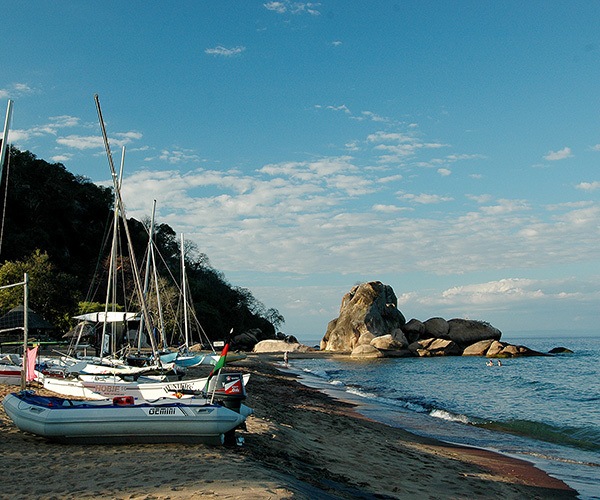 Just a couple of kilometres off-shore is Namalenje Island, which is colonised by birds, including cormorants and fish eagles, and can be visited on a boat trip. Monitor lizards share the island whose rocks and trees are stained white with guano. Despite occasional scare stories, hippos are rarely seen in Lake Malawi but inland from Senga Bay there are a couple of pools where visitors can go and spot a few of these huge grey beasts. Senga is also home to the tropical fish farm established by Stuart Grant. Lake Malawi cichlids are highly prized aquarium fish and the farm was set up to breed them for export the North American and European tropical fish markets.
Because of the popularity of Senga Bay, there is a line of craft stalls along the main road down to the bay where. There can be over 100 metre stretches of stalls on both sides of the road. There are some high quality products on sale, especially the wood carvings, and for something personal, your name can carved onto a key tag in the shape of a fish!
Just a couple of kilometres off-shore is Namalenje Island, which is colonised by birds, including cormorants and fish eagles, and can be visited on a boat trip. Monitor lizards share the island whose rocks and trees are stained white with guano. Despite occasional scare stories, hippos are rarely seen in Lake Malawi but inland from Senga Bay there are a couple of pools where visitors can go and spot a few of these huge grey beasts. Senga is also home to the tropical fish farm established by Stuart Grant. Lake Malawi cichlids are highly prized aquarium fish and the farm was set up to breed them for export the North American and European tropical fish markets.
Because of the popularity of Senga Bay, there is a line of craft stalls along the main road down to the bay where. There can be over 100 metre stretches of stalls on both sides of the road. There are some high quality products on sale, especially the wood carvings, and for something personal, your name can carved onto a key tag in the shape of a fish!
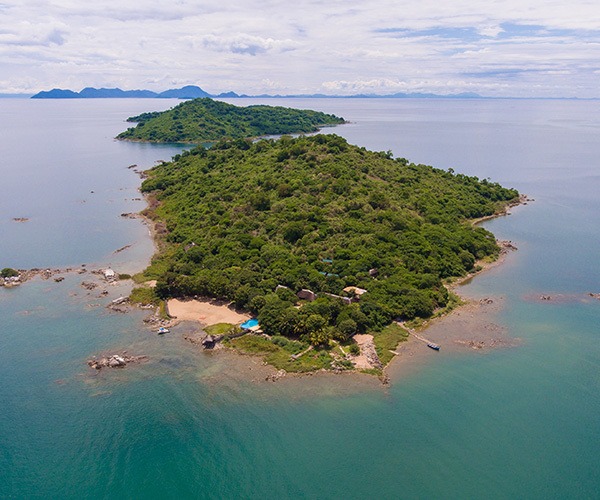 Senga Bay has a variety of accommodation available. Kumbali Lake Retreat is one of the newest, a charming rustic eco lodge. Blue Waters by Serendib has plenty of facilities and activities available and is one of the more popular hotels. But the most luxurious lodge in the area is actually a 15 minute boat trip off shore from Senga Bay, on the uninhabited Marelli Islands, which are part of the Lake Malawi National Park. That is Blue Zebra Island Lodge, a real gem.
Dedza & Chongoni
Dedza township lies roughly 80 km south of Lilongwe, at an altitude of 1600 metres, making it the highest town in Malawi. Dedza is a pleasant forestry town and an important centre for a this long-settled area. Perhaps because of its attractive moist and cool climate various groups have made the area their home over the centuries. Evidence of some of the earliest of those settlers can be found in the Chongoni Rock Art site close to Dedza. This is a World Heritage Site, one of only two in Malawi. Rock shelters, dating from Neolithic times contain geometric paintings, the work of the Batwa people who hunted the then abundant wildlife on the cool slopes of the plateau. There is a wonderful sense of history to be felt standing in the homes of the hunters and food gatherers who inhabited the area two or three thousand years ago.
Senga Bay has a variety of accommodation available. Kumbali Lake Retreat is one of the newest, a charming rustic eco lodge. Blue Waters by Serendib has plenty of facilities and activities available and is one of the more popular hotels. But the most luxurious lodge in the area is actually a 15 minute boat trip off shore from Senga Bay, on the uninhabited Marelli Islands, which are part of the Lake Malawi National Park. That is Blue Zebra Island Lodge, a real gem.
Dedza & Chongoni
Dedza township lies roughly 80 km south of Lilongwe, at an altitude of 1600 metres, making it the highest town in Malawi. Dedza is a pleasant forestry town and an important centre for a this long-settled area. Perhaps because of its attractive moist and cool climate various groups have made the area their home over the centuries. Evidence of some of the earliest of those settlers can be found in the Chongoni Rock Art site close to Dedza. This is a World Heritage Site, one of only two in Malawi. Rock shelters, dating from Neolithic times contain geometric paintings, the work of the Batwa people who hunted the then abundant wildlife on the cool slopes of the plateau. There is a wonderful sense of history to be felt standing in the homes of the hunters and food gatherers who inhabited the area two or three thousand years ago.
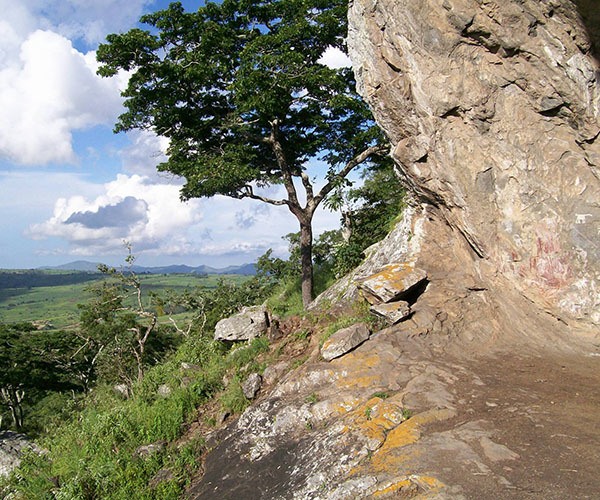 It is possible to hike up the Dedza Mountain (2170 metres) in the forest reserve north of the town. Given a bright day the effort is worth it because once up on the ridge there are spectacular views to the east. In clear air it is possible to see right across Lake Malawi and into Mozambique.
However, many visitors arrive in Dedza simply to visit the township’s famous pottery. The workshops are on the edge of the town, near to the main M1 road. The brick buildings, with their smoking chimneys, are quite extensive. It is possible to watch the potters at work and a tour of the workshop can usually be arranged without prior notice. Much of the pottery is colourful with hand-painted designs, many distinctly African in nature. Many of Malawi’s lodges and hotels use Dedza Pottery products in their restaurants or even when decorating guest rooms. Should you want something unusual or have a specific design in mind, this can be arranged and the finished work forwarded to you by the pottery. If the pots don’t impress, the cakes in the garden teashop behind the workshops are well worth investigating. Tables and chairs are arranged in a neatly kept garden and this is a fine place to rest on a journey between Lilongwe and Blantyre.
It is possible to hike up the Dedza Mountain (2170 metres) in the forest reserve north of the town. Given a bright day the effort is worth it because once up on the ridge there are spectacular views to the east. In clear air it is possible to see right across Lake Malawi and into Mozambique.
However, many visitors arrive in Dedza simply to visit the township’s famous pottery. The workshops are on the edge of the town, near to the main M1 road. The brick buildings, with their smoking chimneys, are quite extensive. It is possible to watch the potters at work and a tour of the workshop can usually be arranged without prior notice. Much of the pottery is colourful with hand-painted designs, many distinctly African in nature. Many of Malawi’s lodges and hotels use Dedza Pottery products in their restaurants or even when decorating guest rooms. Should you want something unusual or have a specific design in mind, this can be arranged and the finished work forwarded to you by the pottery. If the pots don’t impress, the cakes in the garden teashop behind the workshops are well worth investigating. Tables and chairs are arranged in a neatly kept garden and this is a fine place to rest on a journey between Lilongwe and Blantyre.
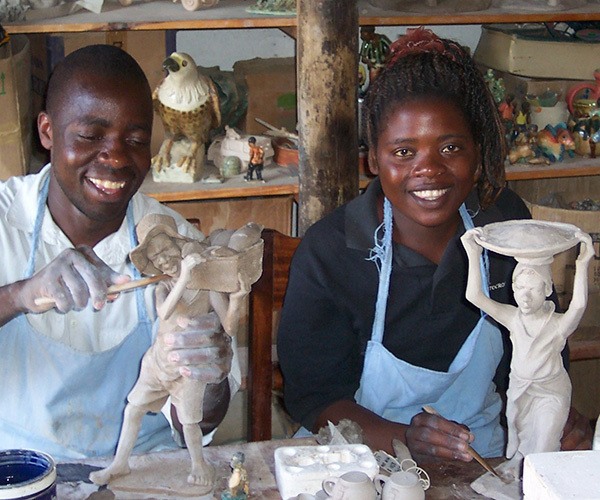 Mua Mission
Found just off the M5 ‘lakeshore’ road 65 km south of Salima, Mua was the first mission established in Malawi by the Roman Catholic Church, over 100 years ago, back in 1899. The Mua parish, run by the White Fathers, dates from 1903 and stretches from the escarpment, bordering the Great Rift Valley, down to the plains by Lake Malawi. A village has grown up round the nucleus of the parish buildings.
The modern development of the mission owes mush to a Canadian White Father, Claude Boucher, who founded the KuNgoni Centre of Culture & Art in 1976. The aim was to harness the skills of local craftsmen and preserve and celebrate the richness of Malawian culture. A museum has been established and the mission now acts as a school for wood carvers who will later make their own living from their handiwork throughout Malawi and beyond. The work is not limited to wood carving; pottery, paintings and batiks are also produced.
Mua Mission
Found just off the M5 ‘lakeshore’ road 65 km south of Salima, Mua was the first mission established in Malawi by the Roman Catholic Church, over 100 years ago, back in 1899. The Mua parish, run by the White Fathers, dates from 1903 and stretches from the escarpment, bordering the Great Rift Valley, down to the plains by Lake Malawi. A village has grown up round the nucleus of the parish buildings.
The modern development of the mission owes mush to a Canadian White Father, Claude Boucher, who founded the KuNgoni Centre of Culture & Art in 1976. The aim was to harness the skills of local craftsmen and preserve and celebrate the richness of Malawian culture. A museum has been established and the mission now acts as a school for wood carvers who will later make their own living from their handiwork throughout Malawi and beyond. The work is not limited to wood carving; pottery, paintings and batiks are also produced.
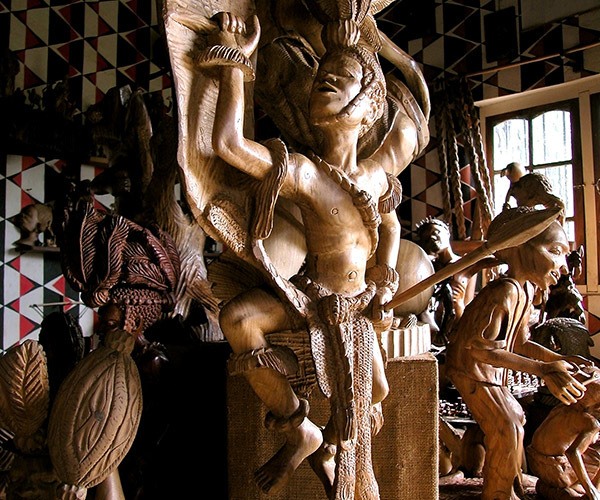 Visitors can see the woodcarvers at work in large open-sided rondavels with heavy thatched roofs providing shade. The pillars supporting the roofs have been carved with scenes portraying the history of Malawi. Much of the work done by these quite extraordinarily skilled craftsmen finds a home in churches around Malawi and overseas but there is a small shop on site which sells smaller and largely secular carvings to visitors. For ridiculously low prices, considering the skills on show, one can come away with a piece of real artistic merit
Visitors can see the woodcarvers at work in large open-sided rondavels with heavy thatched roofs providing shade. The pillars supporting the roofs have been carved with scenes portraying the history of Malawi. Much of the work done by these quite extraordinarily skilled craftsmen finds a home in churches around Malawi and overseas but there is a small shop on site which sells smaller and largely secular carvings to visitors. For ridiculously low prices, considering the skills on show, one can come away with a piece of real artistic merit
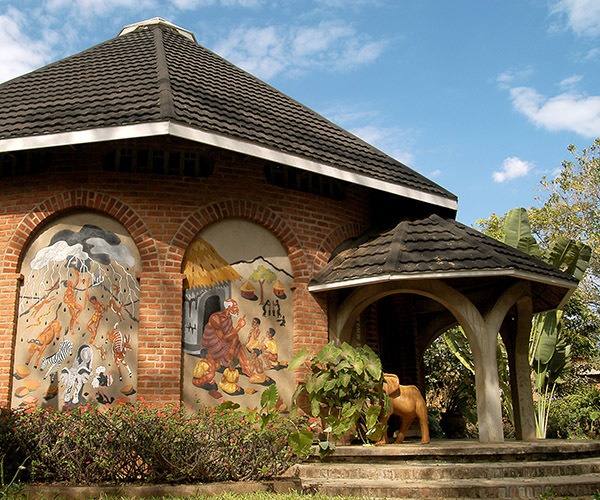 The fascinating Chamare Museum gives a wonderful insight into Malawian history and cuylture. Its exhibits are unique and well worth a visit. It takes at least an hour, and a knowledgeable guide to Properly to appreciate the museum. The outer walls of the building are painted with murals telling the history of Malawi. Inside, the museum displays various exhibits telling the story of the mission, and celebrating the three ethnic groups of Central Malawi: Chewa, Yao and Ngoni.
Kelly White is Director of the Malawi Travel Marketing Consortium. Malawi Travel Marketing Consortium aims to provide you with the best information to make Malawi your tourism destination.
If you would like to be a guest blogger on A Luxury Travel Blog in order to raise your profile, please contact us.
The fascinating Chamare Museum gives a wonderful insight into Malawian history and cuylture. Its exhibits are unique and well worth a visit. It takes at least an hour, and a knowledgeable guide to Properly to appreciate the museum. The outer walls of the building are painted with murals telling the history of Malawi. Inside, the museum displays various exhibits telling the story of the mission, and celebrating the three ethnic groups of Central Malawi: Chewa, Yao and Ngoni.
Kelly White is Director of the Malawi Travel Marketing Consortium. Malawi Travel Marketing Consortium aims to provide you with the best information to make Malawi your tourism destination.
If you would like to be a guest blogger on A Luxury Travel Blog in order to raise your profile, please contact us.Did you enjoy this article?
Receive similar content direct to your inbox.


You say that “friendly negotiation” is the key to shopping in Lilongwe Old Town but is there any guidance on buying? Depending on where you are in the world I’ve heard it said that you can finish up with an item for a third of its opening price in some places it’s just a 10% reduction.
It will entirely depend on each situation. Certainly, the first price quoted will be a fair bit higher than the traders would ultimately accept. But it’s also important for buyers to keep costs in perspective and be prepared to pay an amount that is reasonable and fair for what they are receiving. An encounter shouldn’t be viewed as a challenge to get the cheapest possible price, but instead as an opportunity to engage in some banter with a local Malawian. If you get something for what you feel is a good price for you, that should be enough. Arguing over a few Malawi Kwacha is not right, and those last few Kwacha will be of much greater value to the local craftsmen and vendors than to most international visitors!
I sort of collect capital cities, not in a Donald Trump style of wanting to buy them. Whenever I arrive in a new country I like to spend a couple of days in the capital. Although urban life with modern technology is everywhere you can still get a sense of the country’s traditions and history from a capital. It then gets even more interesting when you head out to the rural areas and find life very different to what those politicians in the capital had planned. I’d definitely want a couple of days getting to know Lilongwe.
Now I think of it, I can’t recall any of my family or friends, many of them who have travelled quite a lot, ever doing to Malawi. The craft market in Lilongwe Old Town sounds like an interesting one to go to. Never been very good at bartering though! It really is quite a shock to see such a distinct difference between that and the Capital City. Old meets new. Then such gorgeous peacefulness and nature with the islands and bays really does give Malawi that all in one kind of feel to it. It’s surprising you don’t often hear of Malawi being mentioned as a vacation destination, but perhaps that helps in keeping it slightly less crowded with tourists.